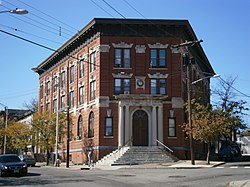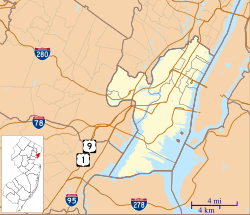
Ridgewood is a railroad station operated by New Jersey Transit in the village of Ridgewood, Bergen County, New Jersey, United States. A major transfer station, Ridgewood has two high-level platforms for the Main Line and Bergen County Line.

Waldwick is a commuter rail station operated by New Jersey Transit in the borough of Waldwick, Bergen County, New Jersey, United States.

The Great Atlantic and Pacific Tea Company Warehouse is a historic formerly commercial building at 150 Bay Street in Jersey City, Hudson County, New Jersey, United States. Built as a warehouse for The Great Atlantic & Pacific Tea Company (A&P) in 1900, it is the major surviving remnant of a five-building complex of the nation's first major grocery store chain. It was designated a National Historic Landmark in 1978, and now houses a mix of residences and storage facilities.

The Maywood Station Museum is located in the 1872-built New York, Susquehanna and Western Railway station in Maywood, New Jersey, United States.

Communipaw is an unincorporated community and neighborhood located within Jersey City in Hudson County, New Jersey, United States. It is located west of Liberty State Park and east of Bergen Hill, and the site of one of the earliest European settlements in North America. It gives its name to the historic avenue which runs from its eastern end near Liberty State Park Station through the neighborhoods of Bergen-Lafayette and the West Side that then becomes the Lincoln Highway. Communipaw Junction, or simply, The Junction, is an intersection where Communipaw, Summit Avenue, Garfield Avenue, and Grand Street meet, and where the toll house for the Bergen Point Plank Road was situated. Communipaw Cove at Upper New York Bay, is part of the 36-acre (150,000 m2) state nature preserve in the park and one of the few remaining tidal salt marshes in the Hudson River estuary.

The Van Wagenen House, also known as Apple Tree House, is located near Bergen Square in Jersey City, Hudson County, New Jersey, United States. The house was added to the National Register of Historic Places on August 16, 2006.

The Old Bergen Church is a historic church congregation in Jersey City, Hudson County, New Jersey, United States. Established in 1660 in what was then the Dutch colony of New Netherland, it is the oldest continuous religious congregation in what is today the State of New Jersey. The congregation is jointly affiliated with the Reformed Church in America and the Presbyterian Church (USA). The church was added to the National Register of Historic Places on August 14, 1973. The original church building was constructed in 1680 and the current edifice was built in 1841.

The Fairmount Apartments, also known as the Grand Lady of Jersey City, are located in Jersey City, Hudson County, New Jersey, United States. The Apartments were added to the National Register of Historic Places on March 3, 1995. The Apartments are an example of an early twentieth century Arts and Crafts style apartments. The building consists of two L-shaped 4 1⁄2-story brick-and-concrete structures connected by a 1-story structure.
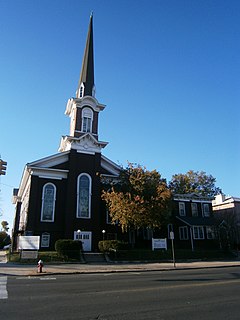
The First Reformed Dutch Church of Bergen Neck, now known as The First Federated Church of Bayonne is located in Bayonne, Hudson County, New Jersey, United States. The church was added to the National Register of Historic Places on April 22, 1982.

The Jersey City YMCA, is located in Bergen Section of Jersey City, Hudson County, New Jersey, United States. The YMCA building was added to the National Register of Historic Places on November 12, 1999. The building is an example of an early twentieth century Renaissance Revival style. Built in 1923, in 1995 the building ceased to be used by the YMCA and was converted into affordable housing.
Bergen-Lafayette is a section of Jersey City, New Jersey.

The Jefferson Trust Company is a historic building located in Hoboken, Hudson County, New Jersey, United States. The building was built in 1912 and was added to the National Register of Historic Places on February 13, 1986. The original trust company failed during the Great Depression and the building passed on to a succession of owners. The building was constructed using granite and brick. Much of the original plaster interior remains intact. The building underwent a renovation into luxury condos in the 2000s.

Highland Hose No. 4 is located in Kearny, Hudson County, New Jersey, United States. The firehouse was added to the National Register of Historic Places on May 29, 1987. The firehouse was constructed in 1894 to be used by Highland Hose No. 4. The firehouse is currently used as a meeting hall for the Firemen's Mutual Benevolent Association. Locals refer to the building as "The Exempts".

The Bayonne Community Museum is located in the Bergen Point section of Bayonne, Hudson County, New Jersey, United States.

Pohlmann's Hall is a building located in Jersey City, Hudson County, New Jersey, United States. The building was added to the National Register of Historic Places on September 5, 1985.

Edwin A. Stevens Hall is located in Hoboken, Hudson County, New Jersey, United States. The building was added to the National Register of Historic Places on February 4, 1994. The building was designed by Richard Upjohn and built in 1870. The building was named after Edwin Augustus Stevens and used as the main building for the Stevens Institute of Technology. The renowned DeBaun Auditorium, which is over 100 years old, is located in this building. The building is currently used as the Charles V. Schaefer, Jr. School of Engineering and Science.
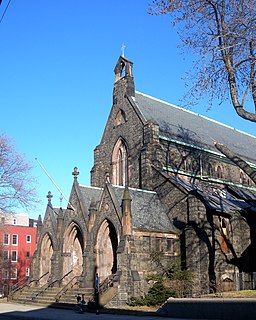
Bergen Hill the name given to the emergence of the Hudson Palisades along the Bergen Neck peninsula in Hudson County, New Jersey and the inland neighborhood of the Jersey City where they rise from the coastal plain at the Upper New York Bay. The name is taken from the original 17th-century New Netherland settlement of Bergen, which in Dutch means hills.
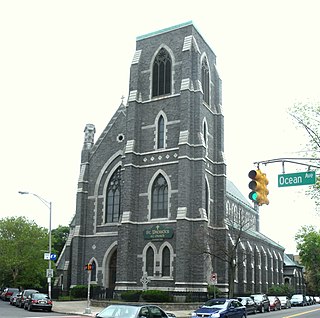
St. Patrick's Parish and Buildings is a historic church on Grand Street, Ocean and Bramhall Avenues in Jersey City, Hudson County, New Jersey, United States. It was built in 1868 and added to the National Register of Historic Places in 1980. The stained glass windows in the church were destroyed in the Black Tom explosion of 1916.

The Bergen Section of Jersey City, New Jersey is the neighborhood on either side of Kennedy Boulevard between Saint Peter's College/ McGinley Square and Communipaw Avenue in the Bergen-Lafayette section of the city. The name Bergen, used throughout Hudson County, is taken from the original Bergen, New Netherland settlement at Bergen Square.

Erie Railroad Signal Tower, Waldwick Yard is located in Waldwick, Bergen County, New Jersey, United States. The tower was built in 1886 and was added to the National Register of Historic Places on December 23, 1987.
